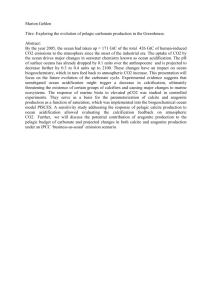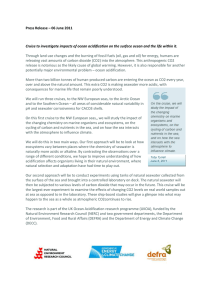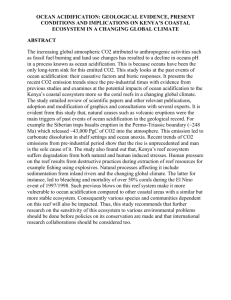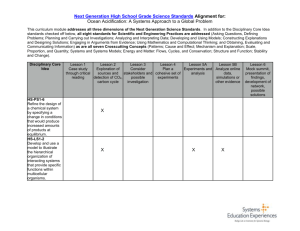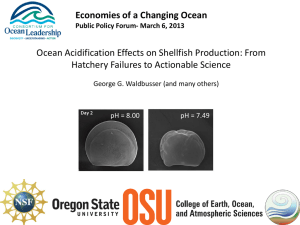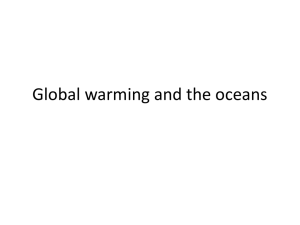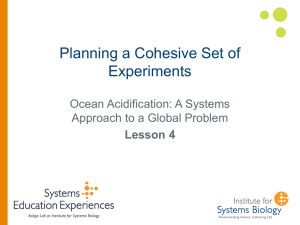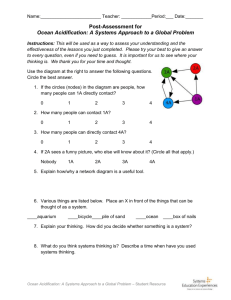O hange lobal C
advertisement
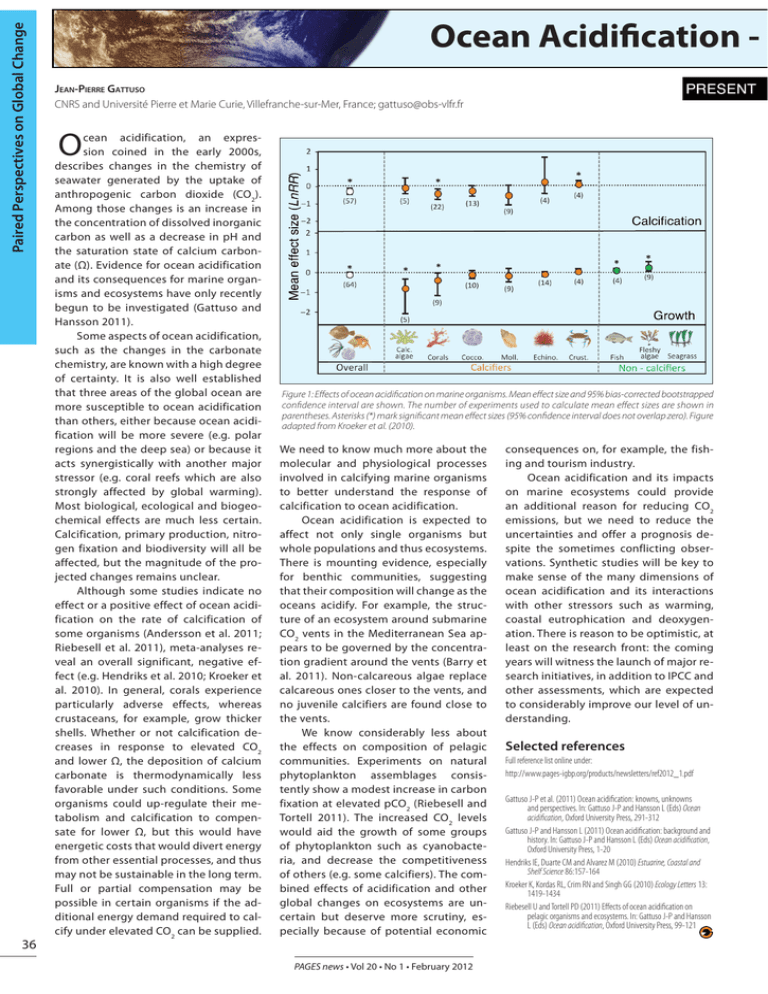
Paired Perspectives on Global Change 36 Ocean Acidification Jean-Pierre Gattuso CNRS and Université Pierre et Marie Curie, Villefranche-sur-Mer, France; gattuso@obs-vlfr.fr O cean acidification, an expression coined in the early 2000s, describes changes in the chemistry of seawater generated by the uptake of anthropogenic carbon dioxide (CO2). Among those changes is an increase in the concentration of dissolved inorganic carbon as well as a decrease in pH and the saturation state of calcium carbonate (Ω). Evidence for ocean acidification and its consequences for marine organisms and ecosystems have only recently begun to be investigated (Gattuso and Hansson 2011). Some aspects of ocean acidification, such as the changes in the carbonate chemistry, are known with a high degree of certainty. It is also well established that three areas of the global ocean are more susceptible to ocean acidification than others, either because ocean acidification will be more severe (e.g. polar regions and the deep sea) or because it acts synergistically with another major stressor (e.g. coral reefs which are also strongly affected by global warming). Most biological, ecological and biogeochemical effects are much less certain. Calcification, primary production, nitrogen fixation and biodiversity will all be affected, but the magnitude of the projected changes remains unclear. Although some studies indicate no effect or a positive effect of ocean acidification on the rate of calcification of some organisms (Andersson et al. 2011; Riebesell et al. 2011), meta-analyses reveal an overall significant, negative effect (e.g. Hendriks et al. 2010; Kroeker et al. 2010). In general, corals experience particularly adverse effects, whereas crustaceans, for example, grow thicker shells. Whether or not calcification decreases in response to elevated CO2 and lower Ω, the deposition of calcium carbonate is thermodynamically less favorable under such conditions. Some organisms could up-regulate their metabolism and calcification to compensate for lower Ω, but this would have energetic costs that would divert energy from other essential processes, and thus may not be sustainable in the long term. Full or partial compensation may be possible in certain organisms if the additional energy demand required to calcify under elevated CO2 can be supplied. Figure 1: Effects of ocean acidification on marine organisms. Mean effect size and 95% bias-corrected bootstrapped confidence interval are shown. The number of experiments used to calculate mean effect sizes are shown in parentheses. Asterisks (*) mark significant mean effect sizes (95% confidence interval does not overlap zero). Figure adapted from Kroeker et al. (2010). We need to know much more about the molecular and physiological processes involved in calcifying marine organisms to better understand the response of calcification to ocean acidification. Ocean acidification is expected to affect not only single organisms but whole populations and thus ecosystems. There is mounting evidence, especially for benthic communities, suggesting that their composition will change as the oceans acidify. For example, the structure of an ecosystem around submarine CO2 vents in the Mediterranean Sea appears to be governed by the concentration gradient around the vents (Barry et al. 2011). Non-calcareous algae replace calcareous ones closer to the vents, and no juvenile calcifiers are found close to the vents. We know considerably less about the effects on composition of pelagic communities. Experiments on natural phytoplankton assemblages consistently show a modest increase in carbon fixation at elevated pCO2 (Riebesell and Tortell 2011). The increased CO2 levels would aid the growth of some groups of phytoplankton such as cyanobacteria, and decrease the competitiveness of others (e.g. some calcifiers). The combined effects of acidification and other global changes on ecosystems are uncertain but deserve more scrutiny, especially because of potential economic PAGES news • Vol 20 • No 1 • February 2012 consequences on, for example, the fishing and tourism industry. Ocean acidification and its impacts on marine ecosystems could provide an additional reason for reducing CO2 emissions, but we need to reduce the uncertainties and offer a prognosis despite the sometimes conflicting observations. Synthetic studies will be key to make sense of the many dimensions of ocean acidification and its interactions with other stressors such as warming, coastal eutrophication and deoxygenation. There is reason to be optimistic, at least on the research front: the coming years will witness the launch of major research initiatives, in addition to IPCC and other assessments, which are expected to considerably improve our level of understanding. Selected references Full reference list online under: http://www.pages-igbp.org/products/newsletters/ref2012_1.pdf Gattuso J-P et al. (2011) Ocean acidification: knowns, unknowns and perspectives. In: Gattuso J-P and Hansson L (Eds) Ocean acidification, Oxford University Press, 291-312 Gattuso J-P and Hansson L (2011) Ocean acidification: background and history. In: Gattuso J-P and Hansson L (Eds) Ocean acidification, Oxford University Press, 1-20 Hendriks IE, Duarte CM and Alvarez M (2010) Estuarine, Coastal and Shelf Science 86:157-164 Kroeker K, Kordas RL, Crim RN and Singh GG (2010) Ecology Letters 13: 1419-1434 Riebesell U and Tortell PD (2011) Effects of ocean acidification on pelagic organisms and ecosystems. In: Gattuso J-P and Hansson L (Eds) Ocean acidification, Oxford University Press, 99-121 Ellen Thomas1,2 1 Department of Geology and Geophysics, Yale University, New Haven, USA; ellen.thomas@yale.edu 2 Department of Earth & Environmental Sciences, Wesleyan University, Middletown, USA S cientists use the geological record to ”look back into the future”, i.e. to evaluate effects of ocean acidification on whole marine ecosystems during carbon cycleclimate perturbations (Pelejero et al. 2010). Fortuitously, calcifying organisms, affected most immediately by decreased carbonate saturation (Fig. 1), have left a fossil record: planktic foraminifera and calcareous nannoplankton (coccolithophores) provide information on the effects of ocean acidification on calcifiers in surface oceans, benthic foraminifera and ostracodes in the deep sea, and corals, calcareous algae, echinoderms, bivalves and gastropods in shelf environments (Kiessling and Simpson 2011). Where in the past can we find clues about future ocean acidification? To look at a world with CO2 levels higher than today (>389 ppm) we need to go back into “Deep Time” (Kump et al. 2009; NRC 2011). During transitions from glacial to interglacial periods over the last 2.6 million years (Ma), atmospheric CO2 levels increased by ~90 ppm over a few thousand years, but from ~175 to ~185 ppm, i.e. well below present levels. Atmospheric CO2 levels may not have been above ~400 ppm for the last 35 Ma, the time since when ice sheets existed on Antarctica. The Deep Time warm worlds are not perfect analogs for the near future, among other reasons because life has evolved since then, but nevertheless may provide useful insights. The long-term high pCO2 and low pH levels in Deep Time did not result in low carbonate saturation states (Ω) in sea water, because on time scales of 10-100 ka the burial of CaCO3 in marine sediments balances the cations released by rock weathering on land, and deep-sea carbonate dissolution buffers the oceans’ Ω. This buffering has been possible only since ~180 Ma, when open-ocean calcifiers evolved and their remains started accumulating as deep-sea carbonates. Since then, only particularly rapid addition of CO2 (over centuries, as during fossil fuel burning) results in a coupled decline of pH and saturation state. Studying past ocean acidification thus requires recognition of times when atmospheric CO2 levels increased rapidly, e.g. from dissociation of methane hydrates from seafloor sediments, methane buildup and release from intrusion of magma into organic-rich sediments, volcanic outgassing, or rapid oceanic turnover of CO2-rich deep waters. Such climate - carbon cycle perturbations are recognized in the geological record by the co-occurrence of a negative carbon isotope excursion (CIE), which reflects the release of large amounts of isotopically light carbon into the ocean-atmosphere system, combined with proxy evidence for global warming and sea floor carbonate dissolution (Kump et al. 2009). During the 543 Ma of Earth history when animals existed (the Phanerozoic), perturbations occurred at the Permo-Triassic (P/Tr) boundary (~250 Ma), the Triassic-Jurassic (Tr/J) boundary (~200 Ma), during Oceanic Anoxic Events (OAEs) between ~183 and 93 Ma (Jurassic-Cretaceous), during the Paleocene-Eocene Thermal Maximum (PETM) (~55 Ma) and during smaller “hyperthermals“ in the Paleogene (~65-40 Ma) (McInerney and Wing 2011). All these events resemble our possible future, with a CIE, global warming, ocean acidification and deoxygenation, thus various stressors affecting the biota. Severe extinctions (including reef biota) occurred at the P/Tr and Tr/J boundaries, i.e. before the evolution of ocean buffering. These early geological events are well suited to provide insight in processes following C-release at rates too rapid for buffering. Later acidification episodes were not associated with severe net extinction of oceanic calcifiers, although coralgal reefs and deep-sea benthic foraminifera suffered extinction during some OAEs and the PETM. Rates of speciation and extinction of calcareous nannoplankton and planktic foraminifera accelerated at or near the OAEs and across the PETM, and “deformed” nannoplankton has been reported, although these could be due to dissolution during or after deposition on the seafloor. The transient floral and faunal changes typically took at least several 10 ka to recover. The best approximations of CO2 emission rates during past carbon cycle perturbations indicate that emissions were considerably slower than the ongoing anthropogenic CO2 emission. The geological record suggests that the human “grand geophysical experiment” is unprecedented, with the high rates of emission potentially having severe and long-term effects on oceanic biota. Paired Perspectives on Global Change How will ongoing ocean acidification affect marine life? Selected references Full reference list online under: http://www.pages-igbp.org/products/newsletters/ref2012_1.pdf Figure 1: The Paleocene-Eocene Thermal Maximum at Walvis Ridge in the southeastern Atlantic Ocean, off Namibia. Paleo-water depth ~1500 m. A) Core image shows carbonate ooze (light colors) and clay (dark colors), where carbonate has been dissolved during ocean acidification (Zachos et al. 2005). Sediment is plotted on an age scale in ka relative to the Paleocene-Eocene Boundary (PEB) (Hönisch et al., in press). B) Blue curve and blue dots show carbon isotope excursion (CIE) in shells of deep-sea benthic foraminifera (McCarren et al. 2008). Red curve shows decrease in number of species of deep-sea benthic foraminifera during extinction coeval with CIE (Thomas, unpublished data). Pictures show specimens of the benthic foraminifer Nuttallides truempyi, used for isotope analysis, survivor of the extinction. All at the same magnification, showing severe decrease in size during ocean acidification, placed at the location where they occurred in the sediment. C) Climate-carbon cycle disturbance in the oceans during the last 300 Ma of Earth history (modified after Kump et al. 2009). PAGES news • Vol 20 • No 1 • February 2012 Hönisch B et al. (in press) Science Kiessling W and Simpson C (2011) Global Change Biology 7: 56-67 Kump LR, Bralower TJ and Ridgwell A (2009) Oceanography 22(4): 94-107 McCarren H et al. (2008) Geochemistry, Geophysics, Geosystems 9, doi: 10.1029/2008GC002116 McInerney FA and Wing SL (2011) Annual Reviews of Earth and Planetary Sciences 39: 489-516 37
